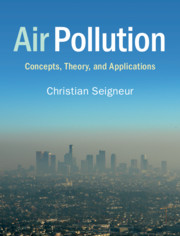Book contents
- Air Pollution
- Air Pollution
- Copyright page
- Contents
- Preface
- Main Notations
- 1 Brief History of Air Pollution
- 2 Emissions of Air Pollutants and Emission Control Technologies
- 3 Meteorology: General Circulation
- 4 Air Pollution Meteorology
- 5 Atmospheric Radiative Transfer and Visibility
- 6 Atmospheric Dispersion
- 7 The Stratospheric Ozone Layer
- 8 Gaseous Pollutants
- 9 Atmospheric Particles
- 10 Clouds and Acid Rain
- 11 Transfer of Pollutants between the Atmosphere and Surfaces
- 12 Health Effects
- 13 Environmental Impacts
- 14 Climate Change and Air Pollution
- 15 Regulations and Public Policies
- Index
- References
2 - Emissions of Air Pollutants and Emission Control Technologies
Published online by Cambridge University Press: 19 June 2019
- Air Pollution
- Air Pollution
- Copyright page
- Contents
- Preface
- Main Notations
- 1 Brief History of Air Pollution
- 2 Emissions of Air Pollutants and Emission Control Technologies
- 3 Meteorology: General Circulation
- 4 Air Pollution Meteorology
- 5 Atmospheric Radiative Transfer and Visibility
- 6 Atmospheric Dispersion
- 7 The Stratospheric Ozone Layer
- 8 Gaseous Pollutants
- 9 Atmospheric Particles
- 10 Clouds and Acid Rain
- 11 Transfer of Pollutants between the Atmosphere and Surfaces
- 12 Health Effects
- 13 Environmental Impacts
- 14 Climate Change and Air Pollution
- 15 Regulations and Public Policies
- Index
- References
Summary
Air pollution is due to emissions of pollutants in the atmosphere, which may be natural or of human origin. Thus, in order to understand air pollution, it is necessary to identify, characterize, and quantify those emissions. Furthermore, reducing air pollution requires either eliminating some of those emissions via a change in a product, process, or technology, or reducing those emissions using some control technologies. This chapter describes the main sources of air pollution and the technologies available to control those emissions. First, air pollutant sources are described. Next, the methods used to quantify the corresponding emissions and develop air pollutant emission inventories are presented. Finally, the main technologies used to control emissions of gaseous and particulate air pollutants are described.
- Type
- Chapter
- Information
- Air PollutionConcepts, Theory, and Applications, pp. 6 - 32Publisher: Cambridge University PressPrint publication year: 2019
References
- 1
- Cited by



